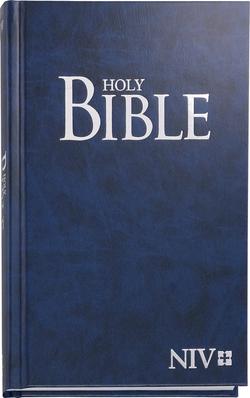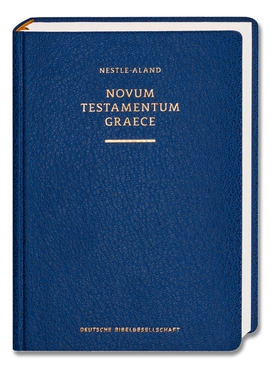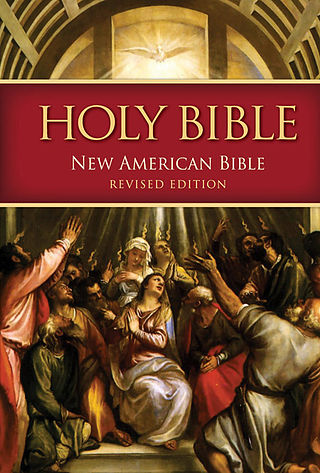Related Research Articles

The King James Version (KJV), also the King James Bible (KJB) and the Authorized Version (AV) is an Early Modern English translation of the Christian Bible for the Church of England, which was commissioned in 1604 and published in 1611, by sponsorship of King James VI and I. The 80 books of the King James Version include 39 books of the Old Testament, 14 books of Apocrypha, and the 27 books of the New Testament. Noted for its "majesty of style", the King James Version has been described as one of the most important books in English culture and a driving force in the shaping of the English-speaking world.

The New International Version (NIV) is a translation of the Bible into contemporary English. Published by Biblica, the complete NIV was released in 1978 with a minor revision in 1984 and a major revision in 2011. The NIV relies on recently-published critical editions of the original Hebrew, Aramaic, and Greek texts.

The Vulgate, sometimes referred to as the Latin Vulgate, is a late-4th-century Latin translation of the Bible.

Today's New International Version (TNIV) is an English translation of the Bible which was developed by the Committee on Bible Translation (CBT). The CBT also developed the New International Version (NIV) in the 1970s. The TNIV is based on the NIV. It is explicitly Protestant like its predecessor; the deuterocanonical books are not part of this translation. The TNIV New Testament was published in March 2002. The complete Bible was published in February 2005. The rights to the text are owned by Biblica. Zondervan published the TNIV in North America. Hodder & Stoughton published the TNIV in the UK and European Union.

The New World Translation of the Holy Scriptures (NWT) is a translation of the Bible published by the Watch Tower Bible and Tract Society; it is used and distributed by Jehovah's Witnesses. The New Testament portion was released first, in 1950, as The New World Translation of the Christian Greek Scriptures, with the complete New World Translation of the Bible released in 1961.

The Geneva Bible is one of the most historically significant translations of the Bible into English, preceding the King James Version by 51 years. It was the primary Bible of 16th century English Protestantism and was used by William Shakespeare, Oliver Cromwell, John Knox, John Donne and others. It was one of the Bibles taken to America on the Mayflower. The Geneva Bible was used by many English Dissenters, and it was still respected by Oliver Cromwell's soldiers at the time of the English Civil War, in the booklet The Souldiers Pocket Bible.

Textus Receptus refers to the succession of printed editions of the Greek New Testament from Erasmus's Novum Instrumentum omne (1516) to the 1633 Elzevir edition.

The Bible has been translated into many languages from the biblical languages of Hebrew, Aramaic, and Greek. As of September 2023 all of the Bible has been translated into 736 languages, the New Testament has been translated into an additional 1,658 languages, and smaller portions of the Bible have been translated into 1,264 other languages according to Wycliffe Global Alliance. Thus, at least some portions of the Bible have been translated into 3,658 languages.

The Revised Standard Version (RSV) is an English translation of the Bible published in 1952 by the Division of Christian Education of the National Council of the Churches of Christ in the USA. This translation itself is a revision of the American Standard Version (ASV) of 1901, and was intended to be a readable and literally accurate modern English translation which aimed to "preserve all that is best in the English Bible as it has been known and used through the centuries" and "to put the message of the Bible in simple, enduring words that are worthy to stand in the great Tyndale-King James tradition."

The Revised Version (RV) or English Revised Version (ERV) of the Bible is a late-19th-century British revision of the King James Version. It was the first officially authorised and recognised revision of the King James Version in Great Britain. The work was entrusted to over 50 scholars from various denominations in Great Britain. American scholars were invited to co-operate, by correspondence. Its New Testament was published in 1881, its Old Testament in 1885, and its Apocrypha in 1894. The best known of the translation committee members were Brooke Foss Westcott and Fenton John Anthony Hort; their fiercest critics of that period were John William Burgon, George Washington Moon, and George Saintsbury.

The Douay–Rheims Bible, also known as the Douay–Rheims Version, Rheims–Douai Bible or Douai Bible, and abbreviated as D–R, DRB, and DRV, is a translation of the Bible from the Latin Vulgate into English made by members of the English College, Douai, in the service of the Catholic Church. The New Testament portion was published in Reims, France, in 1582, in one volume with extensive commentary and notes. The Old Testament portion was published in two volumes twenty-seven years later in 1609 and 1610 by the University of Douai. The first volume, covering Genesis to Job, was published in 1609; the second, covering the Book of Psalms to 2 Maccabees plus the three apocryphal books of the Vulgate appendix following the Old Testament, was published in 1610. Marginal notes took up the bulk of the volumes and offered insights on issues of translation, and on the Hebrew and Greek source texts of the Vulgate.

The New American Standard Bible (NASB) is a translation of the Bible in contemporary English. Published by the Lockman Foundation, the complete NASB was released in 1971. The NASB relies on recently published critical editions of the original Hebrew, Aramaic, and Greek texts.

The American Standard Version (ASV), officially Revised Version, Standard American Edition, is a Bible translation into English that was completed in 1901 with the publication of the revision of the Old Testament. The revised New Testament had been released in 1900.
Early Modern English Bible translations are those translations of the Bible which were made between about 1500 and 1800, the period of Early Modern English. This was the first major period of Bible translation into the English language including the King James Version and Douai Bibles. The Reformation and Counter-Reformation led to the need for Bibles in the vernacular with competing groups each producing their own versions.

Modern English Bible translations consists of English Bible translations developed and published throughout the late modern period to the present.
The Darby Bible refers to the Bible as translated from Hebrew and Greek by John Nelson Darby.

Novum Testamentum Graece is a critical edition of the New Testament in its original Koine Greek, forming the basis of most modern Bible translations and biblical criticism. It is also known as the Nestle–Aland edition after its most influential editors, Eberhard Nestle and Kurt Aland. The text, edited by the Institute for New Testament Textual Research, is currently in its 28th edition, abbreviated NA28.
Bruce Manning Metzger was an American biblical scholar, Bible translator and textual critic who was a longtime professor at Princeton Theological Seminary and Bible editor who served on the board of the American Bible Society and United Bible Societies. He was a scholar of Greek, New Testament, and New Testament textual criticism, and wrote prolifically on these subjects. Metzger was an influential New Testament scholar of the 20th century. He was elected to the American Philosophical Society in 1986.

Bible translations into Chinese include translations of the whole or parts of the Bible into any of the levels and varieties of the Chinese language. The first translations may have been made as early as the 7th century AD, but the first printed translations appeared only in the nineteenth century. Progress on a modern translation was encumbered by denominational rivalries, theological clashes, linguistic disputes, and practical challenges at least until the publication of the Protestant Chinese Union Version in 1919, which became the basis of standard versions in use today.

The New American Bible Revised Edition (NABRE) is an English-language Catholic translation of the Bible, the first major update in 20 years to the New American Bible (NAB), which was translated by members of the Catholic Biblical Association and originally published in 1970. Released on March 9, 2011, the NABRE consists of the 1986 revision of the NAB New Testament with a fully revised Old Testament approved by the United States Conference of Catholic Bishops in 2010.
References
- ↑ |Bruce, F.F.: The History of the Bible in English (Lutterworth Press, 1979), p. 153
- 1 2 Brown, Michael Joseph (2001-01-01). Genesis for Everyone. Westminster John Knox Press. p. 54. ISBN 978-0-664-22941-2.
- 1 2 "Papers relating to The Twentieth Century New Testament - Archives Hub". archiveshub.jisc.ac.uk. Retrieved 2023-08-06.
- ↑ Twentieth Century New Testament, copy in the Internet Archive
- ↑ Metzger, Bruce: The Bible in Translation (Baker Academic, 2001)